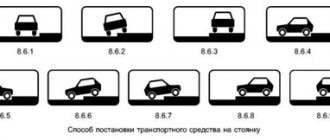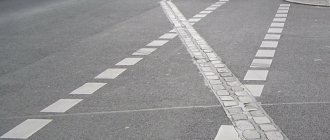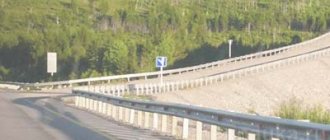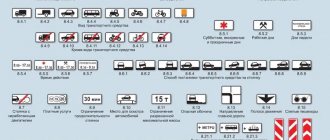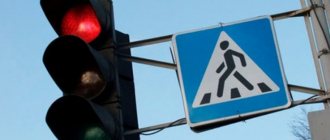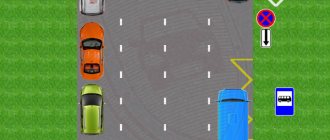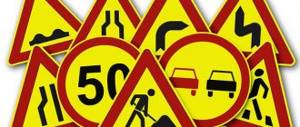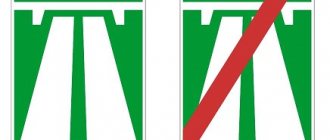Sign on traffic rules tickets
This sign:
More details
Are you allowed to enter the bridge at the same time as the motorcycle driver?
More details
This sign:
More details
Are you allowed to enter the bridge at the same time as the motorcycle driver?
More details
Priority signs are a special category of traffic rules signs that inform traffic participants about the order of crossing intersections, all kinds of roadways or sections of road, the width of which allows only one car to pass. Priority signs have their own specific images, which should be remembered and be able to distinguish from each other. Thus, the category of priority signs includes signs that will notify drivers about the junction of a secondary road, that they cannot cross the intersection without stopping, and about the priority of certain drivers moving towards each other.
Sign 2.6 - The right of way for oncoming traffic is established immediately in front of the very section of the road on which they operate. Knowledge and compliance with traffic rules priority signs is mandatory for every road user, since ignorance of the designation of a particular sign can lead to various types of accidents and the formation of large congestions on a section of the road.
When studying priority signs, you should use various materials that will illustrate the situation in which these signs will work, as this will help you remember them faster, because priority signs, unlike other traffic rules signs, do not have a common range and theme and are maximally different from each other. from each other, making them one of the most difficult categories to learn.
Fines for violations
At the legislative level, punishment is provided for failure to comply with traffic regulations. If the driver of a vehicle does not give way to an oncoming car, he must be punished in the form of:
- warnings;
- a fine of 500 rubles.
If, while driving along a narrow section of the road, the driver does not pay attention to the priority signs, his inattention may cause a serious accident or traffic jam. For failure to comply with the rule provided for by designation 2.6, the motorist must be punished.
Source:
Other organizations
Sign 8.24 - Tow Truck Operating
Indicates that a vehicle is being detained in the coverage area of road signs 3.27 - 3.30.
Sign 8.23 - Photo and video recording
Applicable with signs 1.1, 1.2, 1.8, 1.22, 3.1 - 3.7, 3.18.1, 3.18.2, 3.19, 3.20, 3.22, 3.24, 3.27 - 3.30, 5.14, 5.21, 5.27 and 5.31 , as well as with traffic lights. Indicates that in the coverage area of a road sign or on a given section of the road, administrative offenses can be recorded using automatic special technical means that have the functions of photography, filming and video recording, or by means of photography, filming and video recording.
Sign 8.22.3 - Obstacle
They indicate the obstacle and the direction to avoid it. Used with signs 4.2.1 - 4.2.3.
Sign 8.22.2 - Obstacle
They indicate the obstacle and the direction to avoid it. Used with signs 4.2.1 - 4.2.3.
Sign 8.22.1 - Obstacle
They indicate the obstacle and the direction to avoid it. Used with signs 4.2.1 - 4.2.3.
Sign 8.21.3 - Type of route vehicle
Used with sign 6.4. They indicate where vehicles are parked at metro stations, bus (trolleybus) or tram stops, where transfer to the appropriate mode of transport is possible.
Sign 8.21.2 - Type of route vehicle
Used with sign 6.4. They indicate where vehicles are parked at metro stations, bus (trolleybus) or tram stops, where transfer to the appropriate mode of transport is possible.
Sign 8.21.1 - Type of route vehicle
Used with sign 6.4. They indicate where vehicles are parked at metro stations, bus (trolleybus) or tram stops, where transfer to the appropriate mode of transport is possible.
Sign 8.20.2 - Type of vehicle bogie
Used with sign 3.12. Indicate the number of adjacent axles of the vehicle, for each of which the mass indicated on the sign is the maximum permissible.
Sign 8.20.1 - Type of vehicle bogie
Used with sign 3.12. Indicate the number of adjacent axles of the vehicle, for each of which the mass indicated on the sign is the maximum permissible.
Sign 8.19 - Class of dangerous goods
Indicates the number of the class (classes) of dangerous goods according to GOST 19433-88.
Sign 8.18 - Except for disabled people
Indicates that the sign does not apply to motorized wheelchairs and cars on which the “Disabled” identification sign is installed.
Sign 8.17 - Disabled people
Indicates that the effect of sign 6.4 applies only to motorized wheelchairs and cars on which the “Disabled” identification sign is installed.
Sign 8.16 - Wet surface
Indicates that the sign applies to the period of time when the roadway surface is wet.
Sign 8.15 - Blind pedestrians
Indicates that the pedestrian crossing is used by the blind. Used with signs 1.22, 5.19.1, 5.19.2 and traffic lights.
Sign 8.14 - Traffic lane
Indicates the traffic lane or bicycle lane covered by a sign or traffic light.
Sign 8.13 - Direction of the main road
Indicates the direction of the main road at an intersection.
Sign 8.12 - Dangerous shoulder
Warns that going to the side of the road is dangerous due to repair work being carried out on it. Used with sign 1.25.
Sign 8.11 - Maximum weight limit
Indicates that the sign applies only to vehicles with a permissible maximum weight exceeding the maximum weight indicated on the plate.
Sign 8.10 - Vehicle inspection area
Indicates that on the site marked with sign 6.4 or 7.11 there is an overpass or inspection ditch.
Sign 8.9.1 - Parking for parking permit holders only
Indicates that only vehicles whose owners have a parking permit, obtained in accordance with the procedure established by the executive authorities of a constituent entity of the Russian Federation or local self-government bodies and valid within the territory whose boundaries are established by the relevant executive authorities, can be placed in a parking lot marked with sign 6.4. subject of the Russian Federation or local government bodies.
Sign 8.9 - Limitation of parking duration
Indicates the maximum duration of a vehicle's stay in a parking lot marked with sign 6.4.
Sign 8.8 - Paid services
Indicates that services are provided for a fee only.
Sign 8.7 - Parking with the engine not running
Indicates that in a parking lot marked with sign 6.4, parking of vehicles only with the engine not running is permitted.
Sign 8.6.9 - Method of parking a vehicle
Plaque 8.6.1 indicates that all vehicles must be parked parallel to the edge of the roadway. Plates 8.6.2 - 8.6.9 indicate the method of parking cars and motorcycles in sidewalk parking.
Sign 8.6.8 - Method of parking a vehicle
Plaque 8.6.1 indicates that all vehicles must be parked parallel to the edge of the roadway. Plates 8.6.2 - 8.6.9 indicate the method of parking cars and motorcycles in sidewalk parking.
Sign 8.6.7 - Method of parking a vehicle
Plaque 8.6.1 indicates that all vehicles must be parked parallel to the edge of the roadway. Plates 8.6.2 - 8.6.9 indicate the method of parking cars and motorcycles in sidewalk parking.
Sign 8.6.6 - Method of parking a vehicle
Plaque 8.6.1 indicates that all vehicles must be parked parallel to the edge of the roadway. Plates 8.6.2 - 8.6.9 indicate the method of parking cars and motorcycles in sidewalk parking.
Sign 8.6.5 - Method of parking a vehicle
Plaque 8.6.1 indicates that all vehicles must be parked parallel to the edge of the roadway. Plates 8.6.2 - 8.6.9 indicate the method of parking cars and motorcycles in sidewalk parking.
Sign 8.6.4 - Method of parking a vehicle
Plaque 8.6.1 indicates that all vehicles must be parked parallel to the edge of the roadway. Plates 8.6.2 - 8.6.9 indicate the method of parking cars and motorcycles in sidewalk parking.
Sign 8.6.3 - Method of parking a vehicle
Plaque 8.6.1 indicates that all vehicles must be parked parallel to the edge of the roadway. Plates 8.6.2 - 8.6.9 indicate the method of parking cars and motorcycles in sidewalk parking.
Sign 8.6.2 - Method of parking a vehicle
Plaque 8.6.1 indicates that all vehicles must be parked parallel to the edge of the roadway. Plates 8.6.2 - 8.6.9 indicate the method of parking cars and motorcycles in sidewalk parking.
Sign 8.6.1 - Method of parking a vehicle
Plaque 8.6.1 indicates that all vehicles must be parked parallel to the edge of the roadway. Plates 8.6.2 - 8.6.9 indicate the method of parking cars and motorcycles in sidewalk parking.
Sign 8.5.7 - Time of validity
Indicate the days of the week and time of day during which the sign is valid.
Sign 8.5.6 - Action time
Indicate the days of the week and time of day during which the sign is valid.
Sign 8.5.5 - Time of validity
Indicate the days of the week and time of day during which the sign is valid.
Sign 8.5.4 - Action time
Indicates the time of day during which the sign is valid.
Sign 8.5.3 - Days of the week
Indicate the days of the week during which the sign is valid.
Sign 8.5.2 - Working days
Indicate the days of the week during which the sign is valid.
Sign 8.5.1 - Saturdays, Sundays and holidays
Indicate the days of the week during which the sign is valid.
Sign 8.4.15 -
Indicate the type of vehicle that is not covered by the sign. Plate 8.4.14 does not apply the sign to vehicles used as a passenger taxi.
Sign 8.4.14 - Except for the type of vehicle
Indicate the type of vehicle that is not covered by the sign. Plate 8.4.14 does not apply the sign to vehicles used as a passenger taxi.
Sign 8.4.13 - Except for the type of vehicle
Indicate the type of vehicle that is not covered by the sign. Plate 8.4.14 does not apply the sign to vehicles used as a passenger taxi.
Sign 8.4.12 - Except for the type of vehicle
Indicate the type of vehicle that is not covered by the sign. Plate 8.4.14 does not apply the sign to vehicles used as a passenger taxi.
Sign 8.4.11 - Except for the type of vehicle
Indicate the type of vehicle that is not covered by the sign. Plate 8.4.14 does not apply the sign to vehicles used as a passenger taxi.
Sign 8.4.10 - Except for the type of vehicle
Indicate the type of vehicle that is not covered by the sign. Plate 8.4.14 does not apply the sign to vehicles used as a passenger taxi.
Sign 8.4.9 - Except for the type of vehicle
Indicate the type of vehicle that is not covered by the sign. Plate 8.4.14 does not apply the sign to vehicles used as a passenger taxi.
Sign 8.4.8 - Type of vehicle
Indicate the type of vehicle to which the sign applies. Plate 8.4.1 applies the sign to trucks, including trailers, with a permissible maximum weight of more than 3.5 tons; Plate 8.4.3 - to passenger cars, as well as trucks vehicles with a permissible maximum weight of up to 3.5 tons; Plate 8.4.3.1 - for electric vehicles and hybrid vehicles that can be charged from an external source; Plate 8.4.8 - for vehicles equipped with identification signs (information plates) “Dangerous cargo”.
Sign 8.4.7 - Type of vehicle
Indicate the type of vehicle to which the sign applies. Plate 8.4.1 applies the sign to trucks, including trailers, with a permissible maximum weight of more than 3.5 tons; Plate 8.4.3 - to passenger cars, as well as trucks vehicles with a permissible maximum weight of up to 3.5 tons; Plate 8.4.3.1 - for electric vehicles and hybrid vehicles that can be charged from an external source; Plate 8.4.8 - for vehicles equipped with identification signs (information plates) “Dangerous cargo”.
Sign 8.4.6 - Type of vehicle
Indicate the type of vehicle to which the sign applies. Plate 8.4.1 applies the sign to trucks, including trailers, with a permissible maximum weight of more than 3.5 tons; Plate 8.4.3 - to passenger cars, as well as trucks vehicles with a permissible maximum weight of up to 3.5 tons; Plate 8.4.3.1 - for electric vehicles and hybrid vehicles that can be charged from an external source; Plate 8.4.8 - for vehicles equipped with identification signs (information plates) “Dangerous cargo”.
Sign 8.4.5 - Type of vehicle
Indicate the type of vehicle to which the sign applies. Plate 8.4.1 applies the sign to trucks, including trailers, with a permissible maximum weight of more than 3.5 tons; Plate 8.4.3 - to passenger cars, as well as trucks vehicles with a permissible maximum weight of up to 3.5 tons; Plate 8.4.3.1 - for electric vehicles and hybrid vehicles that can be charged from an external source; Plate 8.4.8 - for vehicles equipped with identification signs (information plates) “Dangerous cargo”.
Sign 8.4.4 - Type of vehicle
Indicate the type of vehicle to which the sign applies. Plate 8.4.1 applies the sign to trucks, including trailers, with a permissible maximum weight of more than 3.5 tons; Plate 8.4.3 - to passenger cars, as well as trucks vehicles with a permissible maximum weight of up to 3.5 tons; Plate 8.4.3.1 - for electric vehicles and hybrid vehicles that can be charged from an external source; Plate 8.4.8 - for vehicles equipped with identification signs (information plates) “Dangerous cargo”.
Sign 8.4.3.1 -
Indicate the type of vehicle to which the sign applies. Plate 8.4.1 applies the sign to trucks, including trailers, with a permissible maximum weight of more than 3.5 tons; Plate 8.4.3 - to passenger cars, as well as trucks vehicles with a permissible maximum weight of up to 3.5 tons; Plate 8.4.3.1 - for electric vehicles and hybrid vehicles that can be charged from an external source; Plate 8.4.8 - for vehicles equipped with identification signs (information plates) “Dangerous cargo”.
Sign 8.4.3 - Type of vehicle
Indicate the type of vehicle to which the sign applies. Plate 8.4.1 applies the sign to trucks, including trailers, with a permissible maximum weight of more than 3.5 tons; Plate 8.4.3 - to passenger cars, as well as trucks vehicles with a permissible maximum weight of up to 3.5 tons; Plate 8.4.3.1 - for electric vehicles and hybrid vehicles that can be charged from an external source; Plate 8.4.8 - for vehicles equipped with identification signs (information plates) “Dangerous cargo”.
Sign 8.4.2 - Type of vehicle
Indicate the type of vehicle to which the sign applies. Plate 8.4.1 applies the sign to trucks, including trailers, with a permissible maximum weight of more than 3.5 tons; Plate 8.4.3 - to passenger cars, as well as trucks vehicles with a permissible maximum weight of up to 3.5 tons; Plate 8.4.3.1 - for electric vehicles and hybrid vehicles that can be charged from an external source; Plate 8.4.8 - for vehicles equipped with identification signs (information plates) “Dangerous cargo”.
Sign 8.4.1 - Type of vehicle
Indicate the type of vehicle to which the sign applies. Plate 8.4.1 applies the sign to trucks, including trailers, with a permissible maximum weight of more than 3.5 tons; Plate 8.4.3 - to passenger cars, as well as trucks vehicles with a permissible maximum weight of up to 3.5 tons; Plate 8.4.3.1 - for electric vehicles and hybrid vehicles that can be charged from an external source; Plate 8.4.8 - for vehicles equipped with identification signs (information plates) “Dangerous cargo”.
Sign 8.3.3 - Directions of action
Indicate the direction of action of signs installed in front of the intersection, or the direction of movement to designated objects located directly next to the road.
Sign 8.3.2 - Directions of action
Indicate the direction of action of signs installed in front of the intersection, or the direction of movement to designated objects located directly next to the road.
Sign 8.3.1 - Directions of action
Indicate the direction of action of signs installed in front of the intersection, or the direction of movement to designated objects located directly next to the road.
Sign 8.2.6 - Coverage area
8.2.2 indicates the coverage area of prohibitory signs 3.27 - 3.30.8.2.3 indicates the end of the coverage area of the signs 3.27 - 3.30.8.2.4 informs drivers that they are in the coverage area of the signs 3.27 - 3.30.8.2.5, 8.2.6 indicates the direction and the coverage area of signs is 3.27 - 3.30 when stopping or parking is prohibited along one side of the square, the facade of a building, etc.
Sign 8.2.5 - Coverage area
8.2.2 indicates the coverage area of prohibitory signs 3.27 - 3.30.8.2.3 indicates the end of the coverage area of the signs 3.27 - 3.30.8.2.4 informs drivers that they are in the coverage area of the signs 3.27 - 3.30.8.2.5, 8.2.6 indicates the direction and the coverage area of signs is 3.27 - 3.30 when stopping or parking is prohibited along one side of the square, the facade of a building, etc.
Sign 8.2.4 - Coverage area
8.2.2 indicates the coverage area of prohibitory signs 3.27 - 3.30.8.2.3 indicates the end of the coverage area of the signs 3.27 - 3.30.8.2.4 informs drivers that they are in the coverage area of the signs 3.27 - 3.30.8.2.5, 8.2.6 indicates the direction and the coverage area of signs is 3.27 - 3.30 when stopping or parking is prohibited along one side of the square, the facade of a building, etc.
Sign 8.2.3 - Coverage area
8.2.2 indicates the coverage area of prohibitory signs 3.27 - 3.30.8.2.3 indicates the end of the coverage area of the signs 3.27 - 3.30.8.2.4 informs drivers that they are in the coverage area of the signs 3.27 - 3.30.8.2.5, 8.2.6 indicates the direction and the coverage area of signs is 3.27 - 3.30 when stopping or parking is prohibited along one side of the square, the facade of a building, etc.
Sign 8.2.2 - Coverage area
8.2.2 indicates the coverage area of prohibitory signs 3.27 - 3.30.8.2.3 indicates the end of the coverage area of the signs 3.27 - 3.30.8.2.4 informs drivers that they are in the coverage area of the signs 3.27 - 3.30.8.2.5, 8.2.6 indicates the direction and the coverage area of signs is 3.27 - 3.30 when stopping or parking is prohibited along one side of the square, the facade of a building, etc.
Sign 8.2.1 - Coverage area
Indicates the length of a dangerous section of the road, indicated by warning signs, or the coverage area of prohibitory signs, as well as signs 5.16, 6.2 and 6.4.
Sign 8.1.4 - Distance to object
Indicate the distance to an object located away from the road.
Sign 8.1.3 - Distance to object
Indicate the distance to an object located away from the road.
Sign 8.1.2 - Distance to object
Indicates the distance from sign 2.4 to the intersection if sign 2.5 is installed immediately before the intersection.
Sign 8.1.1 - Distance to object
Indicates the distance from the sign to the beginning of the dangerous section, the place where the corresponding restriction is introduced, or a specific object (place) located ahead in the direction of travel.
Sign 7.21 - Gas station with the ability to charge electric vehicles
Sign 7.20 - Fire extinguisher
Indicates the location of the fire extinguisher.
Sign 7.19 - Emergency telephone
Indicates the location where the telephone for calling emergency services is located.
Sign 7.18 - Toilet
Sign 7.17 - Pool or beach
Sign 7.16 - Radio communication area with emergency services
A section of road on which a radio communication system with emergency services operates in the civilian 27 MHz band.
Sign 7.15 - Reception area of a radio station transmitting traffic information
A section of road where radio station broadcasts are received at the frequency indicated on the sign.
Sign 7.14 - International road transport control point
Sign 7.13 - Police
Sign 7.12 - Road patrol post
Sign 7.11 - Rest Place
Sign 7.10 - Camping
Sign 7.9 - Hotel or Motel
Sign 7.8 - Drinking water
Sign 7.7 - Food station
Sign 7.6 - Telephone
Sign 7.5 - Car wash
Sign 7.4 - Car maintenance
Sign 7.3 - Gas station
Sign 7.2 - Hospital
Sign 7.1 - Medical aid station
Sign 6.21.2 - Direction of movement to emergency exit
Indicates the direction to the emergency exit and the distance to it.
Sign 6.21.1 - Direction of movement to emergency exit
Indicates the direction to the emergency exit and the distance to it.
Sign 6.20.2 - Emergency exit
Indicates the place in the tunnel where the emergency exit is located.
Sign 6.20.1 - Emergency exit
Indicates the place in the tunnel where the emergency exit is located.
Sign 6.19.2 - Advance indicator for changing lanes onto another carriageway
The direction to bypass a section of the roadway closed to traffic on a road with a dividing strip or the direction of movement to return to the right roadway.
Sign 6.19.1 - Advance indicator for changing lanes onto another carriageway
The direction to bypass a section of the roadway closed to traffic on a road with a dividing strip or the direction of movement to return to the right roadway.
Sign 6.18.3 - Detour direction
The direction to bypass a section of the roadway closed to traffic on a road with a dividing strip or the direction of movement to return to the right roadway.
Sign 6.18.2 - Detour direction
The direction to bypass a section of the roadway closed to traffic on a road with a dividing strip or the direction of movement to return to the right roadway.
Sign 6.18.1 - Detour direction
The direction to bypass a section of the roadway closed to traffic on a road with a dividing strip or the direction of movement to return to the right roadway.
When is it still necessary to give way to oncoming traffic?
Determining the priority right of movement on slopes has its own characteristics. In the absence of signs 2.6 and 2.7, drivers must be guided by other signs or general traffic regulations.
To indicate ascents and descents, signs 1.13 and 1.14 are installed on both sides:
In this case, in accordance with clause 11.7 of the traffic rules, the motorist performing the lift has an advantage. This is due to the fact that starting up a hill is more difficult than starting down a hill.
If difficulties arise with oncoming traffic and there are no signs 2.6 and 2.6, as well as 1.13 and 1.14, the driver in whose lane the obstacle is located must give way. The situation when simultaneous traffic is impossible due to the width of the roadway is not regulated by the legislator. In this case, you should separate by mutual agreement or following the rule: whoever is on top lets you pass.
The bus has an advantage because it starts moving from the stop
Side B has a more logical approach in terms of the traffic situation.
Once again the definition of rebuilding:
“Changing lanes” is leaving an occupied lane or occupied row while maintaining the original direction of movement.
Emphasis on direction of movement. When a stop is made, movement stops. To maintain the original direction, you must start moving. That is, changing lanes is only possible while moving.
If you accept side A, this paragraph practically loses its meaning if the bus starts moving in the same lane, since the car is approaching from behind and cannot physically interfere with the bus. The effect of the paragraph is reduced only for stop pockets in the widening of the roadway in populated areas, however, the text of the Rules indicates all designated stops without exceptions.
The bus starts moving in the right lane
Regarding the title of the chapter “Priority of route vehicles”, in the absence of an advantage when starting from the second lane, route vehicles have practically no additional priority compared to regular transport.
Route vehicles move along an approved route and the organization of a route with a turn immediately after stopping is excluded.
In official traffic police exam papers, the answer where the bus has priority is considered correct.
Question from the exam paper
The official response from the Main Directorate for Road Safety of the Ministry of Internal Affairs of the Russian Federation explained that route vehicles have priority when starting to move, regardless of the trajectory of movement.
Don't forget about politeness and mutual respect on the road. Moreover, allowing one bus with a dozen passengers into the flow is much easier than for a bus driver to wedge himself into a continuous flow.
A sign instructing the driver to give way if vehicle maneuvers are difficult
It is much easier to pass on narrow roads if signs indicate how to do so. For this purpose, there are two signs: one instructs to give way if oncoming traffic is difficult for some reason, and the second informs the driver about the advantages provided for him and is installed on the opposite side.
The first one looks like a circle with a white background and a thick red outline, in the middle of which there are two arrows: a long black one and a short red one. If you see such a sign, it means you must yield to oncoming traffic.
The second sign has the shape of a square filled with blue; it also shows two arrows: red and white. It gives the driver the right to take advantage when passing.
